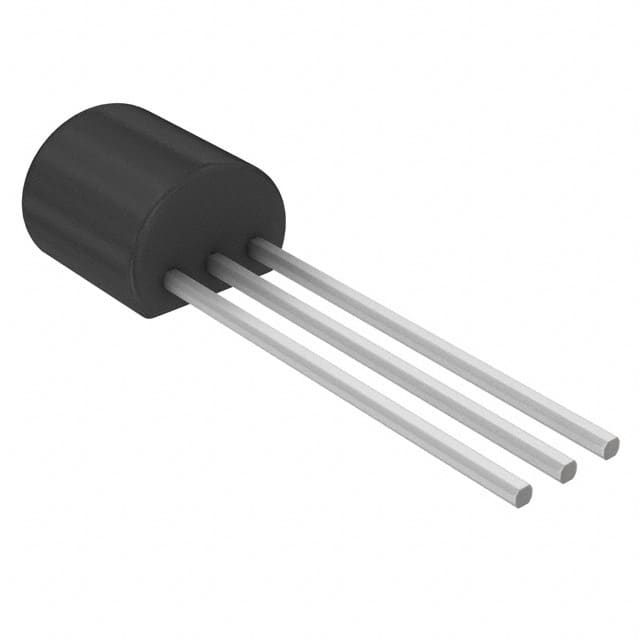BF420,116 Product Overview
Product Category
The BF420,116 belongs to the category of electronic components, specifically within the semiconductor devices segment.
Basic Information Overview
- Use: The BF420,116 is commonly used in electronic circuits for amplification and switching purposes.
- Characteristics: It exhibits high gain, low noise, and excellent linearity, making it suitable for a wide range of applications.
- Package: The BF420,116 is typically available in a TO-92 package, which is a widely used through-hole transistor package.
- Essence: This component serves as a crucial building block in various electronic designs, contributing to signal processing and control functions.
- Packaging/Quantity: It is commonly supplied in reels or tubes, with quantities varying based on manufacturer specifications.
Specifications
- Type: NPN Bipolar Junction Transistor (BJT)
- Maximum Power Dissipation: 0.5W
- Collector-Base Voltage (VCB): 25V
- Collector-Emitter Voltage (VCE): 25V
- Emitter-Base Voltage (VEB): 5V
- Collector Current (IC): 0.1A
- DC Current Gain (hFE): 110 - 800
- Transition Frequency (fT): 250MHz
Detailed Pin Configuration
The BF420,116 features three pins: the emitter, base, and collector. The pinout configuration is as follows: - Emitter (E) - Pin 1 - Base (B) - Pin 2 - Collector (C) - Pin 3
Functional Features
- High Gain: The BF420,116 offers high current gain, enabling efficient signal amplification.
- Low Noise: It exhibits low noise characteristics, making it suitable for sensitive signal processing applications.
- Linearity: The transistor demonstrates excellent linearity, ensuring faithful signal reproduction.
Advantages and Disadvantages
Advantages
- Versatile: Suitable for a wide range of applications due to its high gain and low noise properties.
- Reliable: Known for its reliability and consistent performance in electronic circuits.
Disadvantages
- Limited Power Handling: The maximum power dissipation may restrict its use in high-power applications.
- Temperature Sensitivity: Like many semiconductor devices, the BF420,116 is sensitive to temperature variations.
Working Principles
The BF420,116 operates based on the principles of bipolar junction transistors, utilizing the control of current flow between its terminals to amplify or switch electronic signals.
Detailed Application Field Plans
The BF420,116 finds extensive use in the following application fields: - Audio Amplification: Used in audio amplifiers and preamplifiers due to its low noise characteristics. - Signal Processing: Employed in signal conditioning circuits for sensors and measurement devices. - Control Systems: Integrated into control circuitry for automation and robotics applications.
Detailed and Complete Alternative Models
- BC547: A widely used general-purpose NPN transistor with similar characteristics.
- 2N3904: Another popular NPN transistor known for its versatility and availability.
In conclusion, the BF420,116 serves as a fundamental component in electronic circuits, offering high gain, low noise, and reliable performance across various applications.
Word Count: 466
Lista 10 Vanliga frågor och svar relaterade till tillämpningen av BF420,116 i tekniska lösningar
Sure, here are 10 common questions and answers related to the application of BF420 and BF116 in technical solutions:
What are BF420 and BF116?
- BF420 and BF116 are high-performance epoxy resins commonly used in technical solutions for their excellent adhesion, chemical resistance, and mechanical properties.
What are the typical applications of BF420 and BF116?
- These resins are commonly used in composite manufacturing, aerospace components, automotive parts, electronic encapsulation, and structural bonding.
How do BF420 and BF116 differ from other epoxy resins?
- BF420 and BF116 offer superior thermal stability, exceptional strength, and excellent electrical insulation properties, making them ideal for demanding technical applications.
What is the recommended curing process for BF420 and BF116?
- The recommended curing process typically involves a combination of heat and pressure to achieve optimal mechanical and chemical properties.
Are BF420 and BF116 compatible with different types of reinforcements?
- Yes, these resins are compatible with various reinforcement materials such as carbon fiber, glass fiber, and aramid fiber, providing versatility in composite manufacturing.
How do BF420 and BF116 perform in harsh chemical environments?
- Both resins exhibit excellent chemical resistance, making them suitable for applications where exposure to corrosive substances is a concern.
Can BF420 and BF116 be used for potting and encapsulation of electronic components?
- Yes, these resins are commonly used for potting and encapsulating electronic components due to their ability to protect against moisture, chemicals, and mechanical stress.
Do BF420 and BF116 require any special surface preparation before bonding?
- It is recommended to properly clean and prepare the bonding surfaces to ensure maximum adhesion and performance of BF420 and BF116.
What temperature range can BF420 and BF116 withstand?
- These resins can withstand a wide temperature range, typically from -50°C to 150°C, making them suitable for applications exposed to extreme temperatures.
Are there any safety considerations when working with BF420 and BF116?
- Users should follow proper handling and safety guidelines, including wearing appropriate personal protective equipment and working in well-ventilated areas when using these resins.
I hope this information is helpful! Let me know if you need further assistance.


